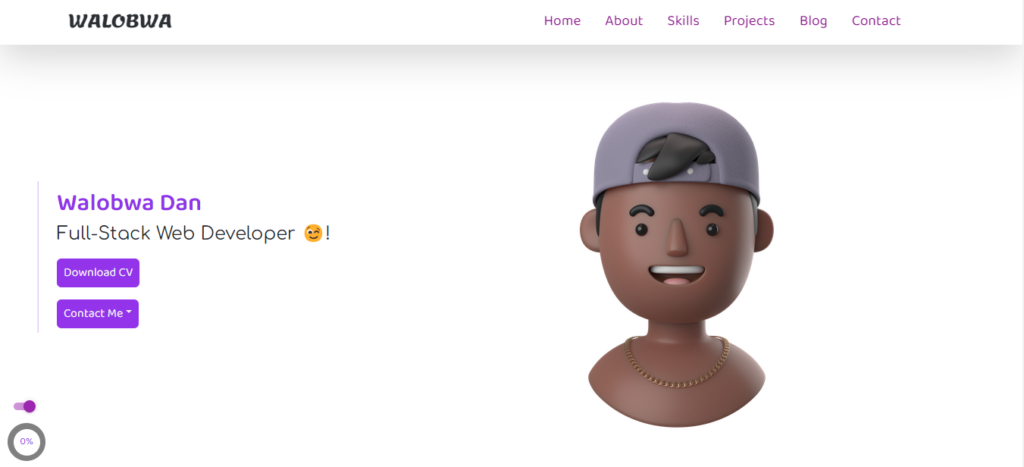Crafting a Compelling Portfolio Website: Your Step-by-Step Guide to Showcase Your Talents and Land Opportunities
A personal portfolio website would be an ideal solution to put you on the path of professional success. How you display yourself out there is crucial, whether it’s sharing your story to the world, advancing your career or even seeking a new job, a portfolio will help you cement your online identity and enhance your discoverability.
Here’s a step by step guide on how to build your online presence and stand out to pursue the new opportunities you are targeting by building a personal portfolio.

What is a Portfolio?
You can define a portfolio as a platform to display professional experience of an individual or even a company, it is mainly used to showcase samples of your best work. A portfolio provides relevant information to potential employers about your skills, experience, and projects you’ve worked on. Think of it as an online resume.
Benefits of a well structured portfolio.
- A portfolio shows evidence of expertise in your field.
- A portfolio is your online resume.
- A portfolio engages potential clients or employers.
- A portfolio helps an individual in tailoring their brand.
- A portfolio exposes networking opportunities to an individual.
- A portfolio can help an individual in showcasing their growth and progression.
Step by Step guide in crafting a good portfolio.
When working on your portfolio site design, think about the elements your future clients should be able to find. Ask yourself – what is the purpose of your portfolio? Do you want to sell your services, are you looking for a job and want to be hired, or is it a website about you? The main focus of your portfolio site should be catching visitor’s attention, and the following elements will help you do that.
1. Establishing Your Professional Brand
You can work on this by defining your Unique Selling Points, pin point your strong skillset or even some of the skills you are working on. The (USPs) are qualities that set you apart from others in your field and will form the foundation of any professional brand.
You can advance by developing a narrative that communicates the journey and motivation, it should be authentic and resonate with your target audience. And finally try to create a consistent visual identity by choosing a cohesive color palette, typography, and logo that align with your brand’s personality and values. Consistency across your portfolio website and other online platforms reinforces your brand’s recognition.
2. Showcasing your best work
When it comes to your work, always select quality over quantity! Feature a carefully curated selection of your top projects or works samples. Focus on showcasing the quality and impact of your work rather than overwhelming your audience with too many pieces.
Tailor your portfolio to include projects that align with your target audience’s interests or the type of work you aspire to attract. Highlighting relevant work helps potential clients or employers see your suitability for their needs. And ideally you might want to try diversifying your work to display your versatility and expertise.
3. Tools and design of the portfolio
Opt for a clean and minimalist design that puts the focus on your work. A clutter-free layout allows your projects to shine and enhances user experience. Use a consistent color scheme, typography, and logo throughout your portfolio to reinforce your personal brand and create a cohesive visual identity.
Ensure your portfolio is fully responsive and optimized for different screen sizes. A mobile-friendly design is crucial as many users browse the web on their smartphones and tablets. Use high-resolution images and media to present your work professionally. Avoid pixelated or distorted visuals that can diminish the impact of your projects.
If you’re a developer, you might want to build the portfolio website from scratch, otherwise you can consider choosing a template for the portfolio and insert you data/projects inside the template. You can get customized templated from wix website templates.
4. Highlighting your skills and expertise
Incorporate visual elements, such as icons or graphics, to enhance the presentation of your skills. Visual aids can make the information more engaging and memorable. Illustrate your proficiency levels for each skill, such as beginner, intermediate, or advanced. This helps potential clients or employers gauge your capabilities accurately.
Create a dedicated section on your portfolio website to showcase your skills. Organize them in a clear and easy-to-read format, possibly using bullet points. Offer brief descriptions or examples of how you have applied each skill in real-world projects or professional experiences. Contextual information adds credibility to your claims. You might also want to consider adding a downloadable link to a copy of your resume.
5. Crafting Engaging About and Contact Pages
Use the About Me page to share your personal and professional journey. Tell your story in an authentic and compelling way to connect with your audience. Also highlight your core values and principles. This helps potential clients or employers understand your ethos and whether it aligns with theirs. Mention significant milestones, achievements, awards, or recognitions you’ve received throughout your career.
Employers or clients might want to contact you, offer various ways for visitors to get in touch, such as an email address, contact form, and social media links. Clearly label the contact form fields, making it easy for visitors to provide the necessary information. If applicable, provide a direct phone number for urgent inquiries or business-related matters.
6. Utilizing SEO and Online Visibility Strategies
Ensure that your portfolio website’s content, including project descriptions and blog posts, is optimized with relevant keywords. This helps search engines understand what your website is about. Include internal links within your website to connect related content and improve user navigation. Additionally, seek opportunities to secure backlinks from reputable websites, as they enhance your website’s authority and SEO rankings. Try to optimize your website’s loading speed by compressing images, minimizing code, and using caching. Faster loading times contribute to better search engine rankings.
7. Seeking Feedback and Testing
Finally, you might want to share your portfolio website with colleagues, friends, or mentors, and ask for their honest feedback. They can offer valuable insights and suggestions for improvement. Participate in online forums or communities related to your industry or profession. Engaging with peers and seeking feedback from like-minded individuals can provide constructive critiques. You can get access and join various communities, read on top communities in Kenya.
Conclusion
In conclusion, a well-crafted portfolio website is the key to effectively showcasing your talents, skills, and expertise to the world. By curating your best work, highlighting your unique strengths, and optimizing for online visibility, you can leave a lasting impression on potential clients or employers.
If you’re seeking for projects to work on and display on your portfolio, Zindua School offers project based learning, kick start your journey and build your personal portfolio.







